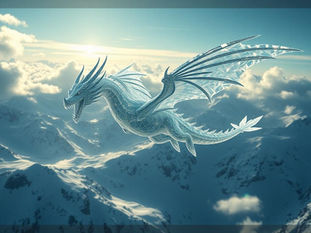
Midjourney's New Video Model: A Leap Forward for AI Anime Creation?
Jul 29
5 min read
0
6
0

A new tool has arrived for creating AI anime. Midjourney, known for its artistic AI images, is now in the world of motion. This new video model is powerful and important for anyone making AI anime. If you like AI anime, telling stories, or are curious about what's possible, you are in the right place.
Midjourney's V1 video model does something many tools struggled with. It brings together dynamic action and strong visual quality. This model also handles many elements at once: movement, depth, lighting, special effects, camera moves, and even how characters look and move physically.
We will explore what makes this model unique. We will also talk about its limits and compare it to other popular tools for AI-generated anime. Stick around for tips on how to get the most from it.
Making Videos in Midjourney: Your Options
When you want to make videos, you have two main ways. You can upload pictures from your computer. Or, you can use images you already made with Midjourney. Choosing an existing Midjourney image is simplest for many.
Motion Settings: High vs. Low
After picking your image, you will see options to make a video. Two main choices are:
[B]Motion High:[/B] This makes the animation more energetic. You get dynamic camera movements and more action from characters. The camera moves, the character moves, and it feels alive. This is good for action scenes.
[B]Motion Low:[/B] This creates a calmer video with less movement. It feels more still. Motion Low is great for calm shots, especially for parts of a story where you want the camera to stay focused on the characters, not move around a lot.
When you see them side by side, the difference is clear. Motion High offers zooms and tracking shots. Motion Low keeps shots stable and steady. Each has its place depending on the mood or scene you want.
Extending Your Animations
After a video is made, you can make it longer. If you click on a video you have already made, the same buttons used to make the first video now let you extend it. You can choose to extend with low motion for a stable look or high motion for more action.
Take Control with Manual Mode and Custom Prompts
The first way to make videos is automatic, reusing the image's original prompt. But there is also a manual mode. In manual mode, you write your own prompt. This gives you more control over what the model makes.
In manual mode, you still choose between low and high motion. But you also get a text box to type your prompt. Use words that describe what you want. For example, use words like "fighting," "powerful impact," or "devastation" for dynamic scenes and strong visuals. You can also add specific camera moves or actions to shape the animation.
When you use manual mode and write prompts for movement, you get much better, more expressive animations. It feels more polished. The automatic mode's results can look flat if the original image prompt was not made for animation.
Creating prompts for video is a skill. It helps to experiment and find what works for you. Do you want to take your Midjourney creations to the next level? Consider the Midjourney Automation Suite from TitanXT. It can help you make the most of your prompts and creative ideas, saving you time and boosting your output.
Extra Settings: Speed and Privacy
In manual mode, you can also adjust settings:
[B]Motion:[/B] High or low, as before.
[B]Fast Mode:[/B] Makes videos quickly but uses your GPU time.
[B]Relax Mode:[/B] Takes more time but offers unlimited video generations (available on Pro plans and above).
[B]Stealth Mode:[/B] Generates videos privately so they do not show in the community feed (also for Pro plans and above).
Using Your Own Images
You are not limited to Midjourney images. You can use your own pictures. Drag and drop your image into the Midjourney interface. Then, add your custom prompt and choose your settings, just like with Midjourney-generated images.
Midjourney’s Video Model: What Makes It Special?
This new model is a big step for AI-generated anime. Many other models exist, like Vidu and Ray 2, which also produce good results. But this new Midjourney model handles movement in a unique way. Making natural-looking motion has been hard for AI. This new model provides smooth, natural, and high-quality movement.
In the past, getting dynamic animation often meant a lot of effort and still lacked consistency. For example, making a hand move naturally was difficult with other tools. With this new model, you can animate actions like hands playing the piano much more easily.
The model also understands prompts well and has great camera control. If you ask for a camera to zoom in on a notebook, it does just that. It gets the hand movements, page turns, and even specific drawings right. It is strong across the board, especially for animation.
Comparing Models: Strengths and Weaknesses
People often ask which model is best. The truth is, different models work well together. This Midjourney model is among the best for its quality and value. But it is good to try different models. Each has its strengths.
For example, Vidu offers a unique 2D visual style. It keeps character looks and design consistent and is very fluid. However, because Vidu focuses on a 2D look, it struggles with depth. Models that create a more 3D look handle depth better. Trying different models helps you find the best tool for your project.
Challenges to Consider
The Midjourney video model does have some challenges:
[B]Sensitive Moderation:[/B] The system can be too strict. Many generations fail even when there is nothing wrong with the image or prompt. This can be frustrating.
[B]Common Visual Glitches:[/B] You might see old problems, like characters talking automatically in close-up shots even when you did not ask them to. Or a character might speak through a mask as if it is not there. These are known issues that updated models have fixed, but they still appear here.
Costs and Efficiency
You might think such a powerful tool is expensive, but it is not. It is one of the most affordable models available. The cost-to-quality ratio is great. For example, you can generate four videos in Relax Mode in just 3 to 5 minutes. That is very fast. Some other platforms are slower even in their fast mode. For about €30, you get over 400 fast-mode video generations. It is a good offer.
Ready to produce more with Midjourney? The Midjourney Automation Suite from TitanXT can help automate parts of your workflow. This can free up your time to focus on creative tasks and produce even more videos.
After Generation: Bringing Your Vision to Life
After creating your video clips, combine them using video editing software like CapCut. Add music and sound effects from libraries or online. You can also add visual effects and voice-overs using tools like Elevenlabs. These steps help bring your animations to life.
Final Thoughts and What's Next
We have reached a new point in AI-generated anime. It is exciting, but there is still much to explore. Creating AI anime involves continuous learning and practice. We plan to share more tutorials soon, covering topics like making fan-made anime and adding voices and sound effects, which are crucial steps.
Do you have questions or ideas for future tutorials? Feel free to share them. We wish you the best with your projects.
To further enhance your Midjourney experience and streamline your creative process, be sure to check out the Midjourney Automation Suite from TitanXT. It is designed to help you generate more, faster, and with greater control.






